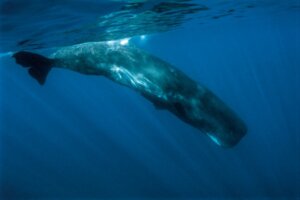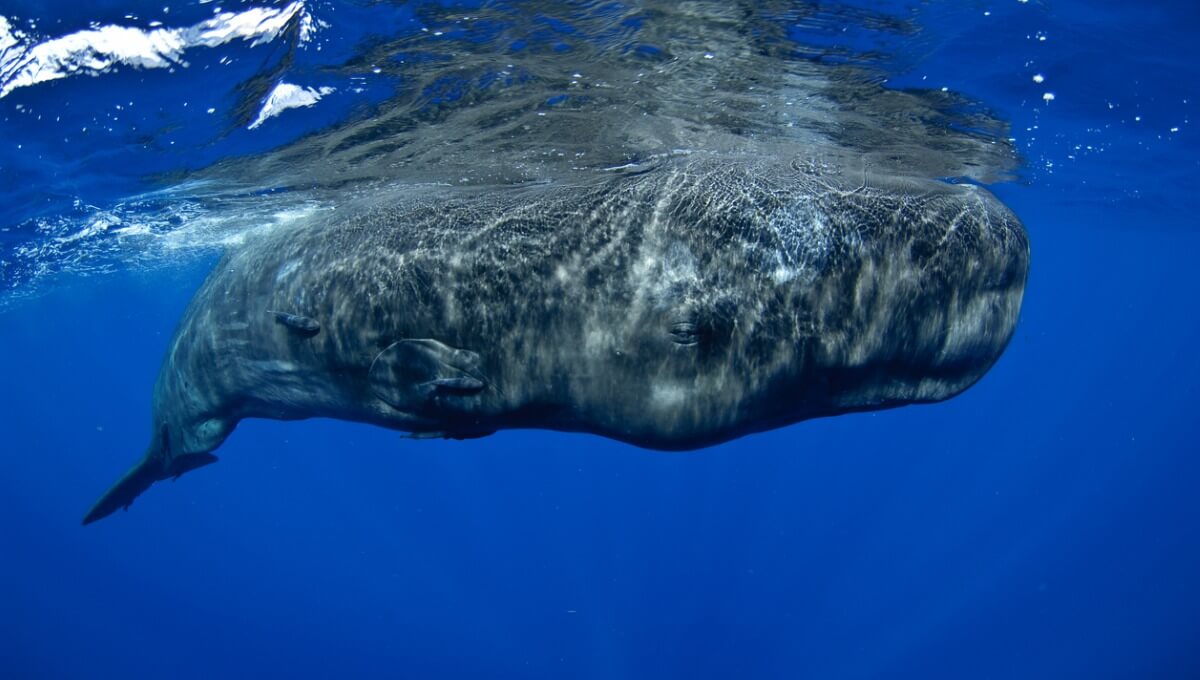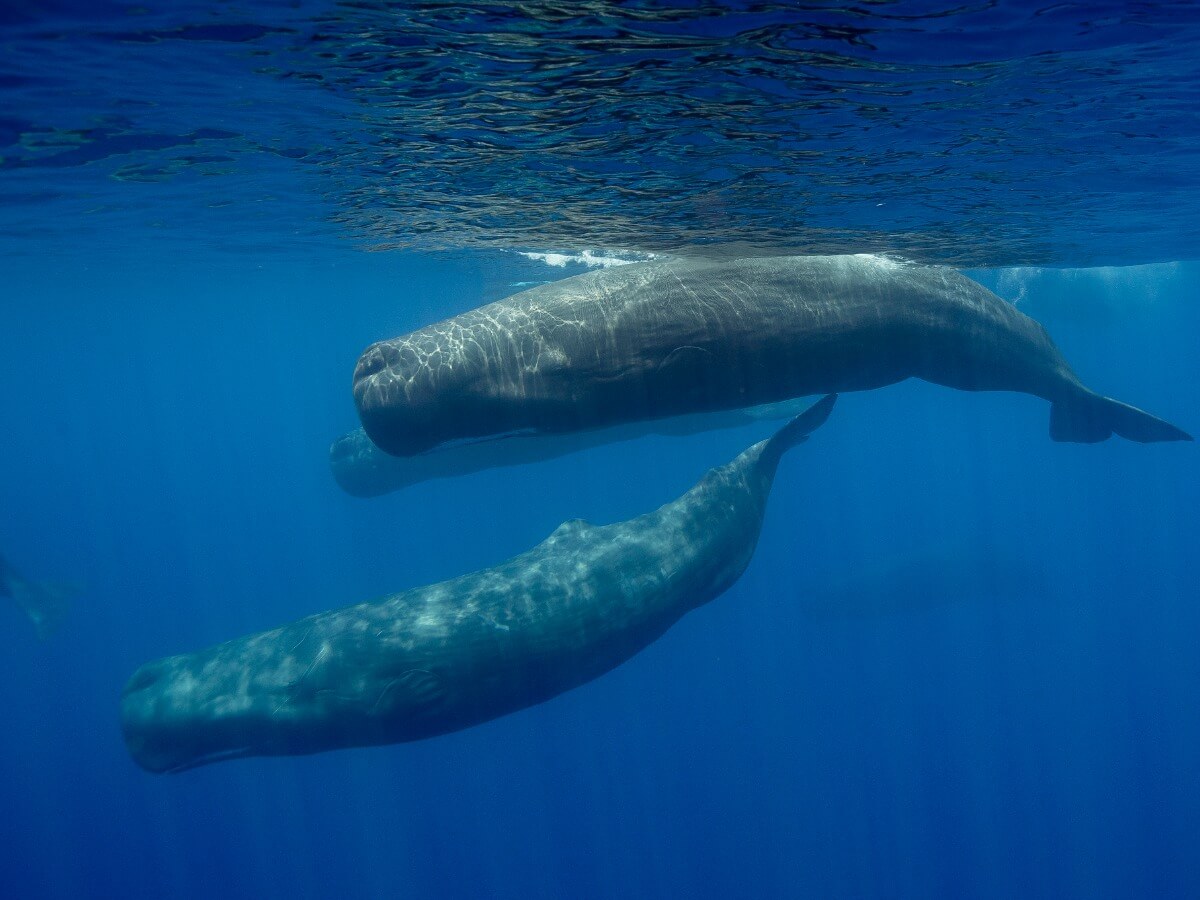6 Curious Facts About the Sperm Whale

The sperm whale, with its characteristic square head, has been the inspiration for great stories and fantasies. Despite their size, spotting these fascinating mammals is a difficult task, and getting to know them is a matter of years of patience and several boat trips.
So far, several interesting things have been discovered about sperm whales that you can read about in the following paragraphs. From its dental structure to its respiratory and immersion mechanism, this titan of the seas leaves no one indifferent.
Sperm whale characteristics
The sperm whale (Physeter macrocephalus) is a species of marine mammal, the only member of the genus Physeter. Despite its appearance, it isn’t a whale, but an odontocete, closer to dolphins and killer whales than to baleen whales. It’s found in the warm areas of all major oceans.
Sperm whales are hunter cetaceans that feed on squid and fish, diving up to 3 kilometers underwater. Some of their prey are giant cephalopods, as suction cup scars can sometimes be seen along their skin. It’s not surprising that these giants have inspired legends!
In addition, it should be noted that odontocetes usually travel in small family groups, since they’re gregarious animals. They reproduce in cycles of between 3 and 4 years and have a single young: gestation lasts 14 to 16 months and lactation between 19 and 42 months. Although the calves suckle for almost a year and a half, there have been cases of young who did so until they were 13 years old.
Anyway, if you have been wanting more, here are 6 curious facts about the sperm whale that you cannot miss.

6 curious facts about the sperm whale
Sperm whales have adapted their lives in every way for survival in the open sea. As their interaction with the terrestrial environment is zero, they have developed a series of impressive characteristics. We’re now going to tell you about them.
1. The biggest head in the world
The sperm whale has the largest head and brain on Earth. Adult males can reach up to 20.5 meters in length and weigh up to 57 tons, which makes this species the largest cetacean in existence. To give you an idea, its brain is 5 times heavier than that of a human being, weighing about 10 kilos in all.
2. Everything about the sperm whale is big
Sperm whales don’t only hold the size record for their head; they also have the largest teeth in the world. In fact, they’re highly valued items for the people of the Pacific Ocean. Their heart isn’t far behind either: it weighs about the same as two adult humans.
3. The loudest animal in the world
The highest sound level ever recorded from an animal was that of a sperm whale off the coast of northern Norway. It reached 235 decibels. To give you an idea of the magnitude of this sound, human beings can only endure 85 decibels for 8 hours in a row before putting themselves at risk.
The sperm whale uses these clicks as part of echolocation, a sense that they use to orient themselves and search for prey. However, it’s hypothesized that, with these clicks, it’s also capable of killing or stunning its victims with the power of the sound waves they create.
4. Moby Dick was a sperm whale?
The famous white whale in the novel wasn’t exactly a sperm whale , as it was based on 2 copies: a whale that sank the Essex ship and a male sperm whale named Mocha Dick. The latter was albino, which inspired the creature’s coloration and square head in the novel.
5. Their feces are important!
Yes, sperm whale feces are of inestimable importance for their ecosystem. When they expel them and float to the surface, they act as fertilizer for the phytoplankton. The photosynthesis of the latter produces most of the oxygen we breathe, so we must be thankful for the natural waste of the sperm whale.
In addition, feces are often coated with ambergris, a substance secreted in the intestine to protect animals from the remains of difficult-to-digest prey – such as the beaks of squids. In the past, this compound was extremely expensive, due to its fixing capacity and because it’s a fundamental part of some perfumes.
6. Sperm whales sleep vertically
At first, experts thought that these marine animals had unihemispheric sleep, like dolphins and other cetaceans, but it seems that this isn’t the case. For this reason, in order to have the blowhole close to the surface sperm whales sleep in an upright position.

This animal, even though it’s so amazing, is sometimes only wanted for its teeth and ambergris, due to beliefs about its healing and aphrodisiac capacities. Although measures are now being taken to protect sperm whales, there’s still a long way to go to ensure that these titans continue to grace the oceans.
The sperm whale, with its characteristic square head, has been the inspiration for great stories and fantasies. Despite their size, spotting these fascinating mammals is a difficult task, and getting to know them is a matter of years of patience and several boat trips.
So far, several interesting things have been discovered about sperm whales that you can read about in the following paragraphs. From its dental structure to its respiratory and immersion mechanism, this titan of the seas leaves no one indifferent.
Sperm whale characteristics
The sperm whale (Physeter macrocephalus) is a species of marine mammal, the only member of the genus Physeter. Despite its appearance, it isn’t a whale, but an odontocete, closer to dolphins and killer whales than to baleen whales. It’s found in the warm areas of all major oceans.
Sperm whales are hunter cetaceans that feed on squid and fish, diving up to 3 kilometers underwater. Some of their prey are giant cephalopods, as suction cup scars can sometimes be seen along their skin. It’s not surprising that these giants have inspired legends!
In addition, it should be noted that odontocetes usually travel in small family groups, since they’re gregarious animals. They reproduce in cycles of between 3 and 4 years and have a single young: gestation lasts 14 to 16 months and lactation between 19 and 42 months. Although the calves suckle for almost a year and a half, there have been cases of young who did so until they were 13 years old.
Anyway, if you have been wanting more, here are 6 curious facts about the sperm whale that you cannot miss.

6 curious facts about the sperm whale
Sperm whales have adapted their lives in every way for survival in the open sea. As their interaction with the terrestrial environment is zero, they have developed a series of impressive characteristics. We’re now going to tell you about them.
1. The biggest head in the world
The sperm whale has the largest head and brain on Earth. Adult males can reach up to 20.5 meters in length and weigh up to 57 tons, which makes this species the largest cetacean in existence. To give you an idea, its brain is 5 times heavier than that of a human being, weighing about 10 kilos in all.
2. Everything about the sperm whale is big
Sperm whales don’t only hold the size record for their head; they also have the largest teeth in the world. In fact, they’re highly valued items for the people of the Pacific Ocean. Their heart isn’t far behind either: it weighs about the same as two adult humans.
3. The loudest animal in the world
The highest sound level ever recorded from an animal was that of a sperm whale off the coast of northern Norway. It reached 235 decibels. To give you an idea of the magnitude of this sound, human beings can only endure 85 decibels for 8 hours in a row before putting themselves at risk.
The sperm whale uses these clicks as part of echolocation, a sense that they use to orient themselves and search for prey. However, it’s hypothesized that, with these clicks, it’s also capable of killing or stunning its victims with the power of the sound waves they create.
4. Moby Dick was a sperm whale?
The famous white whale in the novel wasn’t exactly a sperm whale , as it was based on 2 copies: a whale that sank the Essex ship and a male sperm whale named Mocha Dick. The latter was albino, which inspired the creature’s coloration and square head in the novel.
5. Their feces are important!
Yes, sperm whale feces are of inestimable importance for their ecosystem. When they expel them and float to the surface, they act as fertilizer for the phytoplankton. The photosynthesis of the latter produces most of the oxygen we breathe, so we must be thankful for the natural waste of the sperm whale.
In addition, feces are often coated with ambergris, a substance secreted in the intestine to protect animals from the remains of difficult-to-digest prey – such as the beaks of squids. In the past, this compound was extremely expensive, due to its fixing capacity and because it’s a fundamental part of some perfumes.
6. Sperm whales sleep vertically
At first, experts thought that these marine animals had unihemispheric sleep, like dolphins and other cetaceans, but it seems that this isn’t the case. For this reason, in order to have the blowhole close to the surface sperm whales sleep in an upright position.

This animal, even though it’s so amazing, is sometimes only wanted for its teeth and ambergris, due to beliefs about its healing and aphrodisiac capacities. Although measures are now being taken to protect sperm whales, there’s still a long way to go to ensure that these titans continue to grace the oceans.
All cited sources were thoroughly reviewed by our team to ensure their quality, reliability, currency, and validity. The bibliography of this article was considered reliable and of academic or scientific accuracy.
- Fischer, A. (2021, 4 marzo). Qué es el ámbar gris, la materia fecal del cachalote más valiosa que el oro por su aroma. National Geographic en Español. https://www.ngenespanol.com/animales/que-es-el-ambar-gris-la-materia-fecal-del-cachalote-mas-valiosa-que-el-oro-por-su-aroma/#:%7E:text=A%20la%20hora%20de%20querer,fecales%20con%20una%20coloraci%C3%B3n%20gris%C3%A1cea.
- W. (2019b, septiembre 13). Cachalote (Physeter macrocephalus). CRAM. https://cram.org/catalogo-de-especies/mamiferos-marinos/cetaceos/cachalote/
This text is provided for informational purposes only and does not replace consultation with a professional. If in doubt, consult your specialist.








